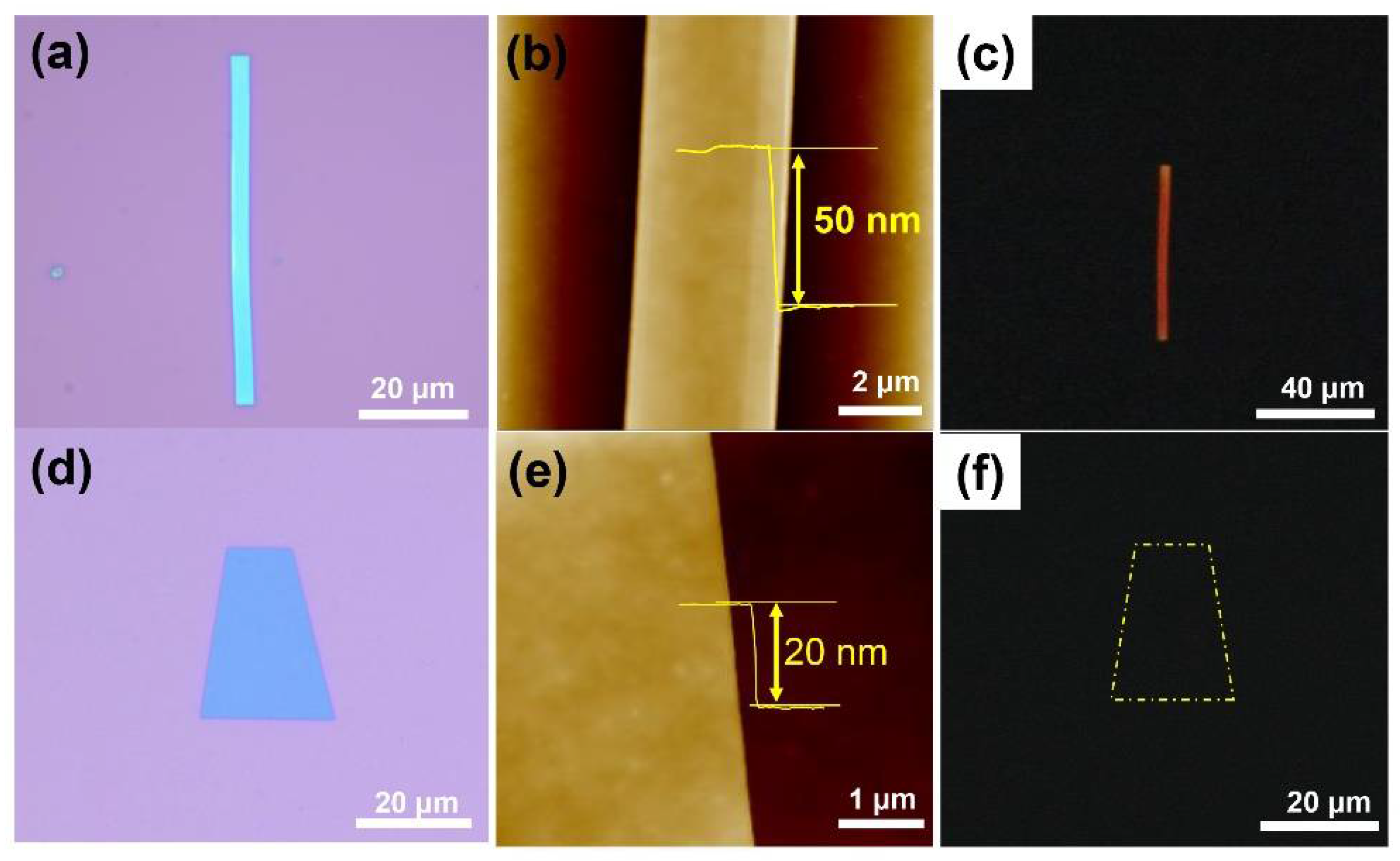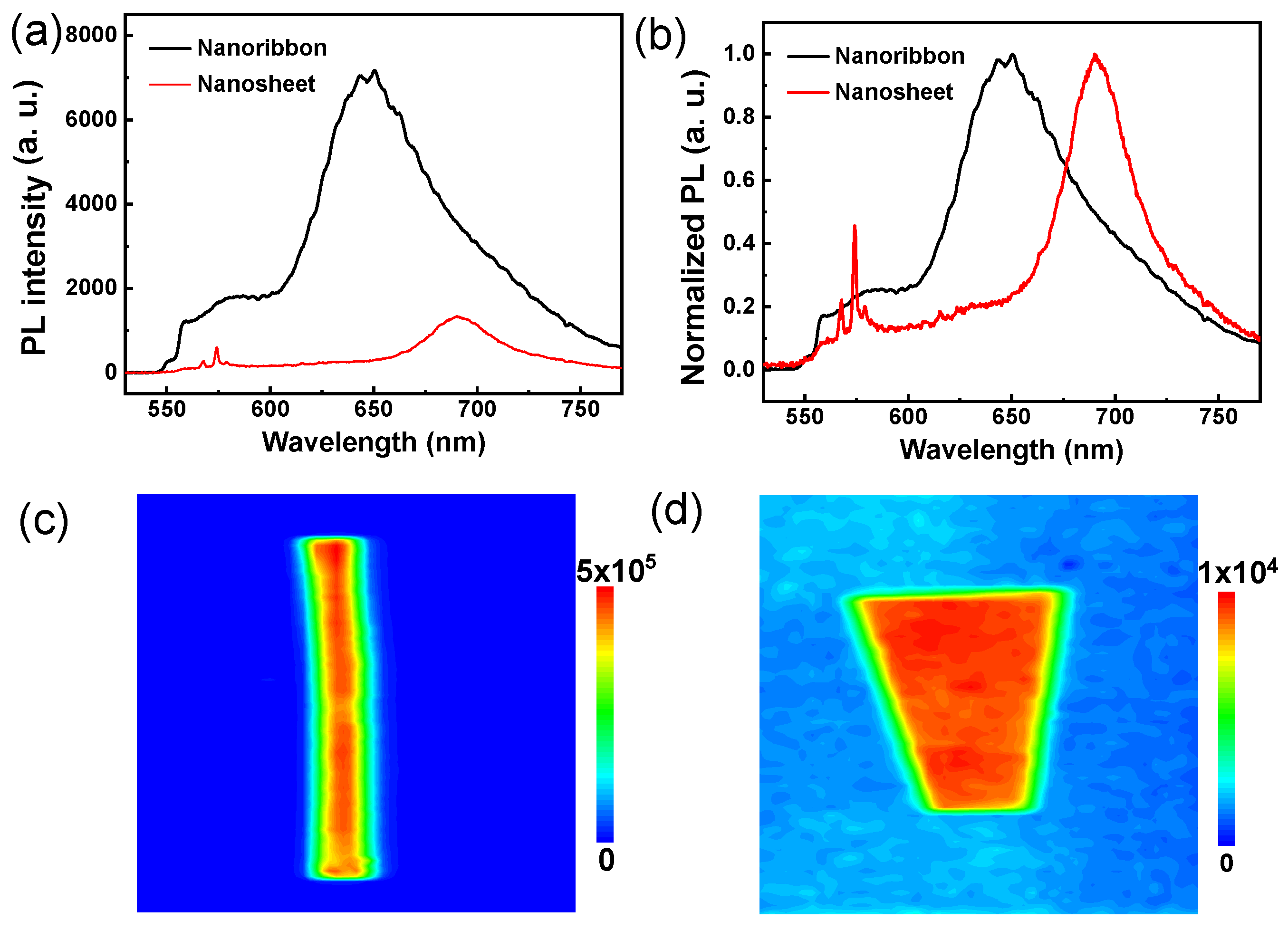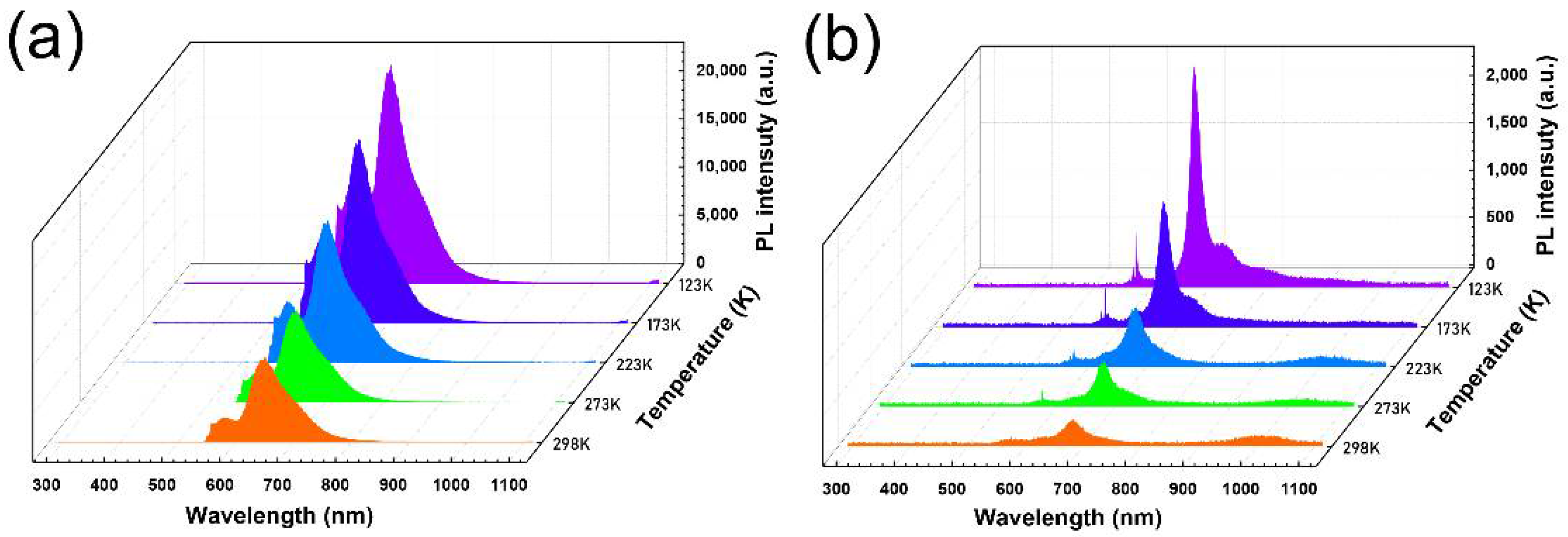Morphology-Dependent Optoelectronic Properties of Pentacene Nanoribbon and Nanosheet Crystallite
Abstract
1. Introduction
2. Experimental Methods
2.1. Materials and Crystals Fabrication
2.2. Characterizations of Pentacene Crystals
3. Results and Discussion
4. Conclusions
Supplementary Materials
Author Contributions
Funding
Data Availability Statement
Conflicts of Interest
References
- Velusamy, A.; Yang, Y.C.; Lin, C.C.; Afraj, S.N.; Jiang, K.X.; Chen, P.S.; Yau, S.L.; Osaka, I.; Tung, S.H.; Chen, M.C.; et al. Solution Processable Pentafluorophenyl End-Capped Dithienothiophene Organic Semiconductors for Hole-Transporting Organic Field Effect Transistors. Adv. Electron. Mater. 2022, 8, 9. [Google Scholar] [CrossRef]
- Liu, S.; Wu, H.N.; Zhang, X.T.; Hu, W.P. Research progress of rubrene as an excellent multifunctional organic semiconductor. Front. Phys. 2021, 16, 15. [Google Scholar] [CrossRef]
- Liu, F.; Hou, X.L.; Hu, B.L.; Li, R.W. Intrinsically Elastic Organic Semiconductors (IEOSs). Molecules 2021, 26, 12. [Google Scholar] [CrossRef] [PubMed]
- Karothu, D.P.; Dushaq, G.; Ahmed, E.; Catalano, L.; Rasras, M.; Naumov, P. Multifunctional Deformable Organic Semiconductor Single Crystals. Angew. Chem. Inter. Ed. 2021, 60, 26151–26157. [Google Scholar] [CrossRef]
- Xie, Y.T.; Cai, K.L.; Chen, P.L.; Liu, Y.; Wang, D.P. Solution-Processed Zirconia Dielectrics with UV/IR Annealing for Organic Film Transistor. Chin. J. Lasers Zhongguo Jiguang 2022, 49, 11. [Google Scholar]
- Kim, J.; Ho, D.; Kim, I.S.; Kim, M.G.; Baeg, K.J.; Kim, C. Solution-processed flexible nonvolatile organic field-effect transistor memory using polymer electret. Org. Electron. 2021, 99, 6. [Google Scholar] [CrossRef]
- Jo, S.; Cho, S.; Yang, U.J.; Hwang, G.S.; Baek, S.; Kim, S.H.; Heo, S.H.; Kim, J.Y.; Choi, M.K.; Son, J.S. Solution-Processed Stretchable Ag2S Semiconductor Thin Films for Wearable Self-Powered Nonvolatile Memory. Adv. Mater. 2021, 33, 11. [Google Scholar]
- Cranston, R.R.; Vebber, M.C.; Rice, N.A.; Tonnele, C.; Castet, F.; Muccioli, L.; Brusso, J.L.; Lessard, B.H. N-Type Solution-Processed Tin versus Silicon Phthalocyanines: A Comparison of Performance in Organic Thin-Film Transistors and in Organic Photovoltaics. ACS Appl. Electron. Mater. 2021, 3, 1873–1885. [Google Scholar] [CrossRef]
- Dai, D.; Peng, B.Y.; Chen, M.; He, Z.F.; Leung, T.K.W.; Chik, G.K.K.; Fan, S.F.; Lu, Y.; Chan, P.K.L. Organic Field-Effect Transistor Fabricated on Internal Shrinking Substrate. Small 2022, 18, 9. [Google Scholar] [CrossRef]
- Tuktarov, A.R.; Chobanov, N.M.; Sadretdinova, Z.R.; Salikhov, R.B.; Mullagaliev, I.N.; Salikhov, T.R.; Dzhemilev, U.M. New n-type semiconductor material based on styryl fullerene for organic field-effect transistors. Mendeleev Commun. 2021, 31, 641–643. [Google Scholar] [CrossRef]
- Zhang, K.; Kotadiya, N.B.; Wang, X.Y.; Wetzelaer, G.; Marszalek, T.; Pisula, W.; Blom, P.W.M. Interlayers for Improved Hole Injection in Organic Field-Effect Transistors. ACS Adv. Electron. Mater. 2020, 6, 1901352. [Google Scholar] [CrossRef]
- Peng, B.Y.; Ji, X.D.; Jiao, X.C.; Chu, M.; Liu, J.Y.; Li, Y.; Chen, M.; Zhou, Z.W.; Zhang, C.P.; Miao, Q.; et al. A Transfer Method for High-Mobility, Bias-Stable, and Flexible Organic Field-Effect Transistors. Adv. Mater. Technol. 2020, 5, 2000169. [Google Scholar] [CrossRef]
- Du, Q.Q.; Qin, S.C.; Wang, Z.F.; Gan, Y.Q.; Zhang, Y.T.; Fan, L.S.; Liu, Y.L.; Li, S.H.; Dong, R.X.; Liu, C.L.; et al. Highly Sensitive and Ultrafast Organic Phototransistor Based on Rubrene Single Crystals. ACS Appl. Mater. Interface 2021, 13, 57735–57742. [Google Scholar] [CrossRef] [PubMed]
- Qin, S.C.; Du, Q.Q.; Dong, R.X.; Yan, X.L.; Liu, Y.L.; Wang, W.J.; Wang, F.Q. Robust, flexible and broadband photodetectors based on van der Waals graphene/C-60 heterostructures. Carbon 2020, 167, 668–674. [Google Scholar] [CrossRef]
- Qin, S.C.; Chen, X.Q.; Du, Q.Q.; Nie, Z.H.; Wang, X.R.; Lu, H.; Wang, X.Z.; Liu, K.H.; Xu, Y.B.; Shi, Y.; et al. Sensitive and Robust Ultraviolet Photodetector Array Based on Self-Assembled Graphene/C-60 Hybrid Films. ACS Appl. Mater. Interfaces 2018, 10, 38326–38333. [Google Scholar] [CrossRef]
- Qin, S.C.; Qin, X.; Du, Q.Q.; Gan, Y.Q.; Zhang, Y.T.; Wang, A.R.; Yan, X.L.; Dong, R.X.; Liu, Y.L.; Li, S.H.; et al. Self-assembled graphene/BUBD-1 hybrids for ultrasensitive organic phototransistors. J. Mater. Chem. C 2022, 10, 11710–11718. [Google Scholar] [CrossRef]
- Dahlström, S.; Wilken, S.; Zhang, Y.D.; Ahläng, C.; Barlow, S.; Nyman, M.; Marder, S.R.; Österbacka, R. Cross-Linking of Doped Organic Semiconductor Interlayers for Organic Solar Cells: Potential and Challenges. ACS Appl. Energy Mater. 2021, 4, 14458–14466. [Google Scholar] [CrossRef]
- Bertrandie, J.; Han, J.H.; De Castro, C.S.P.; Yengel, E.; Gorenflot, J.; Anthopoulos, T.; Laquai, F.; Sharma, A.; Baran, D. The Energy Level Conundrum of Organic Semiconductors in Solar Cells. Adv. Mater. 2022, 34, 2202575. [Google Scholar] [CrossRef]
- Rodríguez-Seco, C.; Cabau, L.; Privado, M.; de la Cruz, P.; Langa, F.; Sharma, G.D.; Palomares, E. Panchromatic Triple Organic Semiconductor Heterojunctions for Efficient Solar Cells. ACS Appl. Energy Mater. 2020, 3, 12506–12516. [Google Scholar] [CrossRef]
- Kang, H.; Kim, J.S.; Choi, S.R.; Kim, Y.H.; Kim, D.H.; Kim, J.G.; Lee, T.W.; Cho, J.H. Electroplated core-shell nanowire network electrodes for highly efficient organic light-emitting diodes. Nano Converg. 2022, 9, 1. [Google Scholar] [CrossRef]
- Wang, S.; Wang, J.; Lou, Y.; Zhou, Y.; Wang, Z. Environment-Friendly Perovskite Light-Emitting Diodes: Progress and Perspective. Adv. Mater. Interfaces 2022, 9, 2200772. [Google Scholar] [CrossRef]
- Zee, B.; Li, Y.; Wetzelaer, G.; Blom, P. Numerical Device Model for Organic Light-Emitting Diodes Based on Thermally Activated Delayed Fluorescence. Adv. Electro. Mater. 2022, 8, 9. [Google Scholar]
- Tanaka, M.; Auffray, M.; Nakanotani, H.; Adachi, C. Spontaneous formation of metastable orientation with well-organized permanent dipole moment in organic glassy films. Nat. Mater. 2022, 21, 819–825. [Google Scholar] [CrossRef] [PubMed]
- Park, K.; Vijayan, R.; Andrew, T.L. Large-Area Heteroepitaxial Nanostructuring of Molecular Semiconductor Films for Enhanced Optoelectronic Response in Flexible Electronics. Adv. Funct. Mater. 2022, 32, 9. [Google Scholar] [CrossRef]
- Bi, Y.G.; Liu, Y.F.; Zhang, X.L.; Yin, D.; Wang, W.Q.; Feng, J.; Sun, H.B. Ultrathin Metal Films as the Transparent Electrode in ITO-Free Organic Optoelectronic Devices. Adv. Opt. Mater. 2019, 7, 23. [Google Scholar] [CrossRef]
- Tang, B.L.; Yu, X.; Zhang, H.Y. Supramolecular Polymorphic Crystals with Luminescence and Elasticity Based on a Single Benzene Framework. Acta Polym. Sin. 2021, 52, 1015–1023. [Google Scholar]
- Zheng, K.L.; Ni, F.; Chen, Z.X.; Zhong, C.; Yang, C.L. Polymorph-Dependent Thermally Activated Delayed Fluorescence Emitters: Understanding TADF from a Perspective of Aggregation State. Angew. Chem. Int. Ed. 2020, 59, 9972–9976. [Google Scholar] [CrossRef]
- He, X.R.; Zhao, J.; Tan, Z.Q.; Zhao, J.X.; Cheng, X.; Zhou, C.J. Chalcone single crystals with red emission and photodimerization-triggered hopping behavior: The substituent effect and molecular packing effect. Crystengcomm 2020, 22, 3110–3114. [Google Scholar] [CrossRef]
- Jiang, H.; Ye, J.; Hu, P.; Zhu, S.L.; Liang, Y.Q.; Cui, Z.D.; Kloc, C.S.; Hu, W.P. Growth direction dependent separate-channel charge transport in the organic weak charge-transfer co-crystal of anthracene–DTTCNQ. Mater. Horiz. 2022, 9, 1057–1067. [Google Scholar] [CrossRef]
- Rao, V.J.; Qi, H.; Berger, F.J.; Grieger, S.; Kaiser, U.; Backes, C.; Zaumseil, J. Liquid Phase Exfoliation of Rubrene Single Crystals into Nanorods and Nanobelts. ACS Nano 2021, 15, 20466–20477. [Google Scholar] [CrossRef]
- Lv, Y.; Xiong, Z.; Dong, H.; Wei, C.; Yang, Y.; Ren, A.; Yao, Z.; Li, Y.; Xiang, S.; Zhang, Z. Pure Metal–Organic Framework Microlasers with Controlled Cavity Shapes. Nano Lett. 2020, 20, 2020–2025. [Google Scholar] [CrossRef]
- Cao, Q.J.; Lu, C.R.; Wang, Q.; Yu, Y.; Wen, S.; Zhao, P.; Shi, B.Y.; Wang, X.D.; Huang, H.; Dou, W.D. Micro-spacing in-air sublimation of submillimeter-scaled rubrene nanoribbons and nanosheets for efficient optical waveguides. Org. Electron. 2020, 87, 8. [Google Scholar] [CrossRef]
- Liu, D.; Li, C.; Niu, S.; Li, Y.; Hu, M.; Li, Q.; Zhu, W.; Zhang, X.; Dong, H.; Hu, W. A case study of tuning the crystal polymorphs of organic semiconductors towards simultaneously improved light emission and field-effect properties. J. Mater. Chem. C 2019, 7, 5925–5930. [Google Scholar] [CrossRef]
- Lei, Y.L.; Sun, Y.Q.; Liao, L.S.; Lee, S.T.; Wong, W.Y. Facet-selective growth of organic heterostructured architectures via sequential crystallization of structurally complementary π-conjugated molecules. Nano Lett. 2017, 17, 695–701. [Google Scholar] [CrossRef] [PubMed]
- Liao, Q.; Wang, Z.; Gao, Q.G.; Zhang, Z.Y.; Ren, J.H.; De, J.B.; Zhang, X.S.; Xu, Z.Z.; Fu, H.B. The effect of 1D-and 2D-polymorphs on organic single-crystal optoelectronic devices: Lasers and field effect transistors. J. Mater. Chem. C 2018, 6, 7994–8002. [Google Scholar] [CrossRef]
- Arabi, S.A.; Dong, J.; Mirza, M.; Yu, P.; Wang, L.; He, J.; Jiang, C. Nanoseed assisted PVT growth of ultrathin 2D pentacene molecular crystal directly onto SiO2 substrate. Cryst. Growth Des. 2016, 16, 2624–2630. [Google Scholar] [CrossRef]
- Ye, X.; Liu, Y.; Han, Q.X.; Ge, C.; Cui, S.Y.; Zhang, L.L.; Zheng, X.X.; Liu, G.F.; Liu, J.; Liu, D.; et al. Microspacing In-Air Sublimation Growth of Organic Crystals. Chem. Mater. 2018, 30, 412–420. [Google Scholar] [CrossRef]
- Mattheus, C.C.; De Wijs, G.A.; De Groot, R.A.; Palstra, T.T.M. Modeling the Polymorphism of Pentacene. J. Am. Chem. Soc. 2003, 125, 6323–6330. [Google Scholar] [CrossRef]
- Cocchi, C.; Breuer, T.; Witte, G.; Draxl, C. Polarized absorbance and Davydov splitting in bulk and thin-film pentacene polymorphs. Phys. Chem. Chem. Phys. 2018, 20, 29724–29736. [Google Scholar] [CrossRef]
- Girlando, A.; Masino, M.; Brillante, A.; Toccoli, T.; Iannotta, S. Raman Identification of Polymorphs in Pentacene Films. Crystals 2016, 6, 10. [Google Scholar] [CrossRef]
- Kim, H.S.; Kim, S.; Koo, J.Y.; Choi, H.C. Highly pure pentacene crystals grown by physical vapor transport: The critical role of the carrier gas. J. Mater. Chem. C 2021, 9, 1911–1917. [Google Scholar] [CrossRef]
- Tomovic, A.Z.; Savic, J.J.; Bakic, N.L.; Bortel, G.; Faigel, G.; Zikic, R.; Jovanovic, V.P. Oxidized pentacene micro-rods obtained by thermal annealing of pentacene thin films in air. Vacuum 2017, 144, 36–42. [Google Scholar] [CrossRef]
- Park, J.E.; Son, M.; Hong, M.; Lee, G.; Choi, H.C. Crystal-Plane-Dependent Photoluminescence of Pentacene 1D Wire and 2D Disk Crystals. Angew. Chem. Inter. Ed. 2012, 51, 6383–6388. [Google Scholar] [CrossRef]
- Mattheus, C.C.; Dros, A.B.; Baas, J.; Meetsma, A.; de Boer, J.L.; Palstra, T.T.M. Polymorphism in pentacene. Acta Crystallogr. C 2001, 57, 939–941. [Google Scholar] [CrossRef] [PubMed]
- Djuric, T.; Ules, T.; Flesch, H.G.; Plank, H.; Shen, Q.A.; Teichert, C.; Resel, R.; Ramsey, M.G. Epitaxially Grown Films of Standing and Lying Pentacene Molecules on Cu (110) Surfaces. Cryst. Growth Des. 2011, 11, 1015–1020. [Google Scholar] [CrossRef] [PubMed]
- Jones, D.K.; Gavvalapalli, N. Controlling the π-Stack Growth Direction in Organic π-Conjugated Microcrystals. Cryst. Growth Des. 2021, 22, 1–19. [Google Scholar] [CrossRef]
- Park, C.; Park, J.E.; Choi, H.C. Crystallization-induced properties from morphology-controlled organic crystals. Acc. Chem. Res 2014, 47, 2353–2364. [Google Scholar] [CrossRef]
- Alsalloum, A.Y.; Turedi, B.; Zheng, X.P.; Mitra, S.; Zhumekenov, A.A.; Lee, K.J.; Maity, P.; Gereige, I.; AlSaggaf, A.; Rogan, I.S.; et al. Low-Temperature Crystallization Enables 21.9% Efficient Single-Crystal MAPbI (3) Inverted Perovskite Solar Cells. ACS Energy Lett. 2020, 5, 657–662. [Google Scholar] [CrossRef]
- Liu, B.; Liu, H.; Zhang, H.Y.; Di, Q.; Zhang, H.Y. Crystal Engineering of a Hydrazone Molecule toward High Elasticity and Bright Luminescence. J. Phys. Chem. Lett. 2020, 11, 9178–9183. [Google Scholar] [CrossRef]
- Martinez-Abadia, M.; Gimenez, R.; Ros, M.B. Self-Assembled alpha-Cyanostilbenes for Advanced Functional Materials. Adv. Mater. 2018, 30, 39. [Google Scholar] [CrossRef]
- Martinez-Abadia, M.; Varghese, S.; Romero, P.; Gierschner, J.; Gimenez, R.; Ros, M.B. Highly Light-Sensitive Luminescent Cyanostilbene Flexible Dimers. Adv. Opt. Mater. 2017, 5, 10. [Google Scholar] [CrossRef]
- Li, W.L.; Huang, Q.Y.; Mao, Z.; Zhao, J.; Wu, H.Y.; Chen, J.R.; Yang, Z.; Li, Y.; Yang, Z.Y.; Zhang, Y.; et al. Selective Expression of Chromophores in a Single Molecule: Soft Organic Crystals Exhibiting Full-Colour Tunability and Dynamic Triplet-Exciton Behaviours. Angew. Chem. Int. Ed. 2020, 59, 3739–3745. [Google Scholar] [CrossRef]
- Markiewicz, G.; Smulders, M.M.J.; Stefankiewicz, A.R. Steering the Self-Assembly Outcome of a Single NDI Monomer into Three Morphologically Distinct Supramolecular Assemblies, with Concomitant Change in Supramolecular Polymerization Mechanism. Adv. Sci. 2019, 6, 10. [Google Scholar] [CrossRef] [PubMed]
- Cheng, X.; Wang, Z.Y.; Tang, B.L.; Zhang, H.Y.; Qin, A.J.; Sun, J.Z.; Tang, B.Z. Diversified Photo/Electronic Functions Based on a Simple Chalcone Skeleton: Effects of Substitution Pattern and Molecular Packing. Adv. Funct. Mater. 2018, 28, 8. [Google Scholar] [CrossRef]





Disclaimer/Publisher’s Note: The statements, opinions and data contained in all publications are solely those of the individual author(s) and contributor(s) and not of MDPI and/or the editor(s). MDPI and/or the editor(s) disclaim responsibility for any injury to people or property resulting from any ideas, methods, instructions or products referred to in the content. |
© 2023 by the authors. Licensee MDPI, Basel, Switzerland. This article is an open access article distributed under the terms and conditions of the Creative Commons Attribution (CC BY) license (https://creativecommons.org/licenses/by/4.0/).
Share and Cite
Wang, Z.; Gan, Y.; Du, Q.; Li, S.; Liu, Y.; Wang, W. Morphology-Dependent Optoelectronic Properties of Pentacene Nanoribbon and Nanosheet Crystallite. Materials 2023, 16, 557. https://doi.org/10.3390/ma16020557
Wang Z, Gan Y, Du Q, Li S, Liu Y, Wang W. Morphology-Dependent Optoelectronic Properties of Pentacene Nanoribbon and Nanosheet Crystallite. Materials. 2023; 16(2):557. https://doi.org/10.3390/ma16020557
Chicago/Turabian StyleWang, Zhifeng, Yuquan Gan, Qianqian Du, Shuhong Li, Yunlong Liu, and Wenjun Wang. 2023. "Morphology-Dependent Optoelectronic Properties of Pentacene Nanoribbon and Nanosheet Crystallite" Materials 16, no. 2: 557. https://doi.org/10.3390/ma16020557
APA StyleWang, Z., Gan, Y., Du, Q., Li, S., Liu, Y., & Wang, W. (2023). Morphology-Dependent Optoelectronic Properties of Pentacene Nanoribbon and Nanosheet Crystallite. Materials, 16(2), 557. https://doi.org/10.3390/ma16020557



